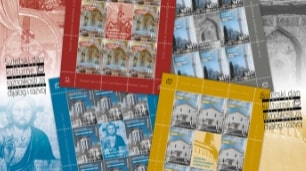Uvjeti korištenja

Croatian Post (HP) Mostar has issued four commemorative stamps and four FDCs in celebrating World Day for Cultural Diversity for Dialogue and Development with commemorative stamps. The universal declaration on cultural diversity was adopted by the General Conference of UNESCO, with the aim to help countries in their own boundaries, to preserve and promote cultural diversity, create preconditions for cultural and civilisational worldwide.
The motifs are the Franciscan church of St Peter and Paul in Mostar, Cathedral Church of the Holy Trinity in Mostar, Mostar Synagogue and the Karađoz-bay's mosque in Mostar that are not only beautiful sacral objects but also special architectural solutions that enrich the city on the Neretva river.
Construction of the Franciscan church of St Peter and Paul began with the laying of the corner stone on 7 March 1866, according to the architectural drawings of the Italian friar Matteo Lorenzoni. The Church survived the First and the Second World War - during the latter it was bombed. In 1987, friars reconstructed it further to authentic design plans. In the night of 9 May 1992, the Yugoslav People's Army (JNA) burned and destroyed the church. With heavy hearts, the friars removed the rubble and built a crypt in that place in 1995, and a new church further to the project made by architect Davor Smoljan. The construction of the church and the 107,2 m-tall belltower was led by the abbot friar Ivan Ševo. The church is still under construction, and the interior is painted in frescoes and mosaics by world renowned artist and Jesuit father Ivan Marko Rupnik.
Cathedral Church of the Holy Trinity in Mostar was built in 1873 and is in Brankovac which represented one of the symbols of the city of Mostar. Magnificent, monumental, and picturesque church dedicated to the Holy Trinity was one of the tallest and the most beautiful orthodox temples in the Balkans. The Church builders were Spasoje Vulić from Herzegovina and the renowned architect Andrey Damyanov Zografski from Veles.
The temple was completely destroyed in the war in 1992. It was shelled on 15 June 1992, then torched and shortly thereafter blown up. Reconstruction of the Church of the Holy Trinity began in 2010. Metropolitan Leontije Radulović was buried in the church in 1888, and his relics were found in 2010 during the reconstruction of the church. Consecration and the laying of the crosses for the reconstructed church took place on 4 November 2018.
According to the archival records from 1570, the first Jewish settlers in Mostar were Sephardic Jews exiled from Spain, Daniel Rodriguez, and Moshe Kohen. The Ashkenazi arrived in the 19th century and together with the earlier Jewish settlers created the joint Jewish denominational municipality, as the first such community in Europe. The Synagogue in Mostar existed as early as the 1889, converted from a building that was previously used for storing hay. Because of the lack of space there was a need to build a larger building, so a Construction committee was established, with David Kohn, David Frommer and L. Rosenfeld as members. Record of a construction of a new synagogue in Brankovac neighborhood, with full documentation, was made on 7 June 1904. The synagogue was partially destroyed in the Second World War. After that it has been rebuilt and converted for the needs of the Puppet Theatre of Mostar and two more wings were added. It has been damaged in the last war and, following a thorough reconstruction in 1996, it has been in use again, as a theatre.
Karađoz-bay's mosque in Mostar was built in 965 AH (1557/58 CE). It is the endowment of the greatest benefactor of Mostar and Herzegovina - Mehmed-bay, also known as Karađoz-bay, originally from the village of Potoci, near Mostar. Karađoz-bay occupied a prominent position in the Ottoman state administration during the second half of the 16th century. The mosque was built further to the design of famous Ottoman architect Koça Mimar Sinan. It falls under the category of domed mosques with a porch situated under three small domes. It is among a small number of mosques that have preserved the original paintings. Painted layers often overlap, ranging from the original arabesques to the late ottoman baroque. During the last war, from 1992 to 1995, the Karađoz-bay's mosque suffered severe destruction. It was repaired in 2002/2004 as part of the project of reconstruction of the Old Bridge and the old town of Mostar.
The stamps were designed by Marin Musa, with the first day issue on May 21rst 2022. This issue, as well as previous issues may be purchased online at www.epostshop.ba